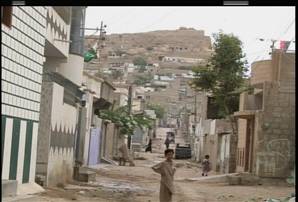The Talibanization of Karachi
BY Herschel SmithThe Captain’s Journal has discussed the influx of Taliban to Karachi before, as well as the fact that it is an important port city through which NATO supplies flow (ultimately through two passes, one at the Torkham Crossing and the other through the Southwestern city of Chaman). But the supplies mainly come into Pakistan through the port of Karachi. There are reports of a massive influx of Taliban into Karachi and the surrounding provinces.
Muttahida Qaumi Movement (MQM) chief Altaf Hussain has said that more than 400,000 Afghans and foreigners equipped with weapons have entered the city and alleged that these terrorists wanted to occupy Karachi and Hyderabad and the entire Sindh.
In a statement issued from London on Sunday, he warned that they did not want to fight anyone but added that if the MQM areas were attacked they would defend themselves in accordance with the UN Charter and Islamic Shariat.
He said that the MQM wanted to make Pakistan a liberal and democratic state and not a country governed by al-Qaeda, Taliban or religious extremists.
“The MQM is against all kinds of extremism and terrorism and wants to give equal rights to each and every segment of the society including minorities.”
This report is probably exaggerated (the total is probably << 400,000), but a much better anecdotal account of the Talibanization of Karachi comes from Richard Engel of NBC News along with his interpreter.
Many Pakistanis attend madrassas because they offer free education, supplementing the government’s lacking public school system. For centuries madrassas were the only form of education in the Islamic world. From Morocco to Indonesia, most madrassas have a similar layout, with a mosque at the center and classrooms upstairs. The vast majority of madrassas are moderate charities that teach religious values, the Koran and the traditions of the Prophet Mohammed.
But some madrassas in Pakistan have churned out suicide bombers indoctrinated in jihad and a paranoid but widespread philosophy that they must attack innocent civilians to defend their faith from the United States, Israel and other modern-day “crusaders.”
Former President Pervez Musharraf promised to reform and regulate Pakistan’s hard-line madrassas. It never happened. According to Karachi’s former mayor Farooq Sattar, there are now more than 2,000 illegal madrassas in Karachi alone. This was one of them.
“What do you think of the Taliban and their influence here?” I asked the students.
More blank stares.
“What do you think about the U.S. incursions?”
That got a reaction.
“God willing, we will fight them,” said one teenager with a purple scar on his chin. “They are the enemy,” he said and launched into a long explanation of America’s goal to occupy Muslim lands and undermine Islam. I’ve heard the same speech from Cairo to Lebanon, Baghdad to Riyadh. God bless the Internet.
A few minutes later my driver/fixer, a very tough guy from a very tough part of Pakistan, tapped me on the shoulder.
“I think you have been here long enough,” he said. It was time to go.
But I still hadn’t seen any Taliban.
Malik suggested we go deeper into the slum, to the neighborhood right under the cliffs and quarries. He was nervous about taking a foreigner, but had an idea. There was a graveyard in the area.
“We can pretend to be offering prayers for the dead,” Malik suggested. “I’ll pray over one of the graves and you can see the neighborhood for yourself.”
Malik said praying at a gravesite would give us an excuse to be in the area and raise less suspicion.
It didn’t exactly work. As soon as I stepped out of the jeep by the gravestones, I was again surrounded by a group of people. They didn’t have weapons or appear threatening, but didn’t attempt to hide their sympathies for the Taliban. One man proudly told me several suicide bombers had prayed in a nearby mosque.
But others were scared of the Taliban. A man who spoke English told me the Taliban were in control of the area.
“Do the Pakistani police or soldiers ever come here?” I asked him. “No, they can’t come here.”
“How do people feel here?”
“We are all frightened. The Taliban has taken over.”
More men, athletically built in their 20s and 30s, started to arrive.
“Who are these people?” I asked the English speaker.
“They are Taliban.”
“Do they understand what we are saying? Do they understand English?”
“No, but you shouldn’t stay here. It is not comfortable here. You should not be here.”
“Who runs this neighborhood?”
“They do.”
The new arrivals didn’t want to be interviewed.
“Stop asking them questions,” the English speaker advised.
We left a few minutes later.
“We couldn’t come here at night,” Malik said as we were driving out of the neighborhood. “Now we had an excuse to come to the graveyard. But at night, there would be no reason to be here.”
Both of these reports point to the same thing, even if in different ways. The campaign is in deep trouble when the main route for supplies, ordnance and fuel is in trouble. If the Taliban have their way, Karachi will not be hospitable for very much longer. Causing a diminution of Taliban capabilities and turning the tide of the campaign is very important, and it’s important to do so in a timely manner.






No comments yet.
RSS feed for comments on this post. TrackBack URL
Leave a comment